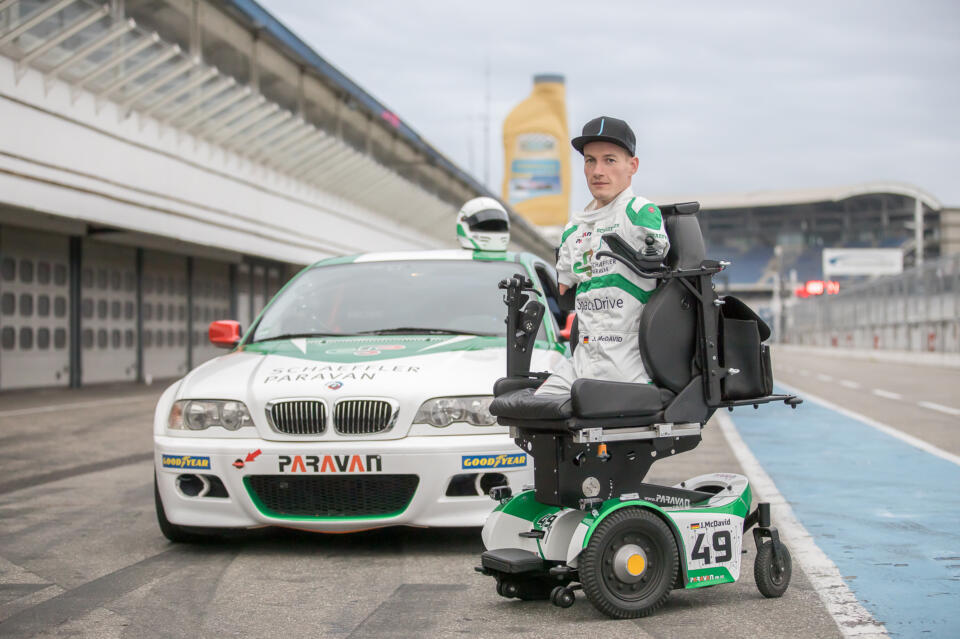
No limits
Janis McDavid will arguably never forget this particular weekend at the end of October 2020: slipping into his purpose-made fire-proof racing suit, donning a helmet and hopping into the BMW race car to zip down the Hockenheim ring at a top speed of 200 km/h (124.3 mph). Through the legendary Parabolika, without hands on the wheel – how else? Instead, there’s a joystick stuck in his armpit. Janis’ maxim is to think without limits. “Even as a child I dreamed of driving cool sports cars,” says the man who’s in his late twenties. Now this dream has come true in a BMW M3. But how does someone without limbs drive a race car?
Janis McDavid owes the fact that a seemingly impossible feat becomes possible to Space Drive drive-by-wire technology with which Paravan GmbH has been enabling severely disabled people to independently drive cars for nearly 20 years – and as a joint venture with Schaeffler since 2018. The Space Drive system uses cables instead of the traditional mechanical connections. Electrical impulses are used to actuate steering, braking and acceleration functions. Three mutually monitoring control chips ensure the system’s safety. Roland Arnold, founder and CEO of Paravan, is the innovator of this technology: “Now seeing Janis driving even on a race track is incredible. Going forward, this technology will be playing a pivotal role in the development of future vehicle concepts and benefit everyone.” Space Drive is regarded as a key technology especially for autonomous driving.
Janis McDavid and his Paravan PR 50

1 Steering
Janis McDavid uses a joystick to operate his wheel chair. Rearward means accelerating, forward means braking. A pad at the level of his right arm is used for other functions
2 Lifting function
The best tool for communicating with others at eye level
3 Branding
The wheel chair (Paravan PR 50) bears the same number as the BMW race car: 49. September 4th is Janis McDavid’s birthday
4 Drive system
Two powerful 300-watt motors take him wherever he’s headed. Either at 6 (3.7) or 10 km/h (6.2 mph). The batteries have an approximate range of 30 km (19 mi) and are charged on downhill sections
320,000 kilometers of freedom
The dream of driving cars has played a major part in Janis McDavid’s life from early childhood on. To personally choose where and when to go somewhere means ultimate freedom to him. For ten years, he’s been driving his Mercedes Sprinter that was modified by Paravan, having covered a distance of 320,000 kilometers (200,000 mi) in it without accidents. Via a loading ramp he steers his high-tech wheel chair, also from Paravan, into the vehicle’s rear and hops forward into the driver’s seat. He operates his mini bus just like the race car by using a 4-way joystick. Backward means accelerating, forward means braking, and to the left and right means steering. “The rest I handle via a multi-functional button at the level of my right arm,” says Janis. Operating the turn signal, for instance. It’s a technology that literally moves. In fall of 2019, the idea of installing this technology in a real race car was born. Roland Arnold showed Janis his most recent project, an Audi R8 LMS GT3, the world’s first sports car without any mechanical connection between the steering unit and the steering gearbox – approved by the German Motorsport Federation (DMSB). So, why not test this technology on a race track using a 4-way joystick? For Janis McDavid, it was clear that he’d accept this driving challenge. “Breaking the 200-km/h (125 mph) ‘sound barrier’ for the first time was a mega feeling. My driving instructor said to me, ‘hey guy, don’t focus on the speedometer, look at the road!’” he says with a smile.

Space Drive has increasingly been gaining traction in racing. In 2020, the Schaeffler technology has been used in five race cars in various sprint races and tests. The plan is for it to be fielded in the new DTM as well, starting in 2023. Following his successful debut in a race car, Janis McDavid is going to keep track of the continuing development: “Who’d have thought that you don’t even need arms and legs to drive a race car?” Right, who’d have thought that! It goes to prove that limits are redefined thanks to innovations.


